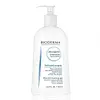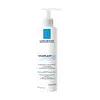Bioderma Atoderm Intensive Gel Moussant Ultra Rich Foaming Gel Versus La Roche-Posay Cicaplast Lavant B5 Purifying Soothing Foaming Gel
What's inside
What's inside
 Key Ingredients
Key Ingredients

 Benefits
Benefits

 Concerns
Concerns

 Ingredients Side-by-side
Ingredients Side-by-side

Water
Skin ConditioningSodium Laureth Sulfate
CleansingLauryl Glucoside
CleansingPEG-200 Hydrogenated Glyceryl Palmate
CleansingDisodium EDTA
PEG-7 Glyceryl Cocoate
EmulsifyingCaprylyl Glycol
EmollientZinc Sulfate
AntimicrobialSodium Chloride
MaskingCopper Sulfate
Skin ConditioningSodium Hydroxide
BufferingCitric Acid
BufferingPolysorbate 20
EmulsifyingNiacinamide
SmoothingFructooligosaccharides
HumectantMannitol
HumectantXylitol
HumectantRhamnose
HumectantWater, Sodium Laureth Sulfate, Lauryl Glucoside, PEG-200 Hydrogenated Glyceryl Palmate, Disodium EDTA, PEG-7 Glyceryl Cocoate, Caprylyl Glycol, Zinc Sulfate, Sodium Chloride, Copper Sulfate, Sodium Hydroxide, Citric Acid, Polysorbate 20, Niacinamide, Fructooligosaccharides, Mannitol, Xylitol, Rhamnose
Water
Skin ConditioningSodium Laureth Sulfate
CleansingPanthenol
Skin ConditioningPEG-200 Hydrogenated Glyceryl Palmate
CleansingGlycerin
HumectantCoco-Betaine
CleansingSodium Chloride
MaskingPolysorbate 20
EmulsifyingPEG-7 Glyceryl Cocoate
EmulsifyingCitric Acid
BufferingCocamide Mea
EmulsifyingCopper Gluconate
Skin ConditioningManganese Gluconate
Skin ConditioningPEG-55 Propylene Glycol Oleate
PEG-60 Hydrogenated Castor Oil
EmulsifyingPolyquaternium-11
PPG-5-Ceteth-20
EmulsifyingPropylene Glycol
HumectantPrunus Amygdalus Dulcis Oil
Skin ConditioningSodium Benzoate
MaskingSodium Hydroxide
BufferingZinc Gluconate
Skin ConditioningWater, Sodium Laureth Sulfate, Panthenol, PEG-200 Hydrogenated Glyceryl Palmate, Glycerin, Coco-Betaine, Sodium Chloride, Polysorbate 20, PEG-7 Glyceryl Cocoate, Citric Acid, Cocamide Mea, Copper Gluconate, Manganese Gluconate, PEG-55 Propylene Glycol Oleate, PEG-60 Hydrogenated Castor Oil, Polyquaternium-11, PPG-5-Ceteth-20, Propylene Glycol, Prunus Amygdalus Dulcis Oil, Sodium Benzoate, Sodium Hydroxide, Zinc Gluconate
 Reviews
Reviews

Ingredients Explained
These ingredients are found in both products.
Ingredients higher up in an ingredient list are typically present in a larger amount.
Citric Acid is an alpha hydroxy acid (AHA) naturally found in citrus fruits like oranges, lemons, and limes.
Like other AHAs, citric acid can exfoliate skin by breaking down the bonds that hold dead skin cells together. This helps reveal smoother and brighter skin underneath.
However, this exfoliating effect only happens at high concentrations (20%) which can be hard to find in cosmetic products.
Due to this, citric acid is usually included in small amounts as a pH adjuster. This helps keep products slightly more acidic and compatible with skin's natural pH.
In skincare formulas, citric acid can:
While it can provide some skin benefits, research shows lactic acid and glycolic acid are generally more effective and less irritating exfoliants.
Most citric acid used in skincare today is made by fermenting sugars (usually from molasses). This synthetic version is identical to the natural citrus form but easier to stabilize and use in formulations.
Read more about some other popular AHA's here:
Learn more about Citric AcidPEG-200 Hydrogenated Glyceryl Palmate isn't fungal acne safe.
Peg-7 Glyceryl Cocoate is created from polyethylene glycol and fatty acids from coconut oil.
It is a synthetic polymer with emulsifying and cleansing properties.
As an emulsifier, Peg-7 Glyceryl Cocoate prevents ingredients such as oils and water from separating. It also helps rinse away oils, dirt, and pollutants from skin.
Peg-7 Glyceryl Cocoate may not be fungal acne safe. It can also dry out skin.
Learn more about PEG-7 Glyceryl CocoatePolysorbate 20 is made by combining ethoxylation of sorbitan, ethylene oxide, and lauric acid. It is a mild cleansing agent, surfactant, and emulsifier.
As a surfactant, it helps collect dirt and oils for washing. Emulsifiers prevent oils and water from separating.
Polysorbate 20 also adds scent to a product. Since it is made using sorbitol, it has a sweet scent. Sorbitol can also be found in fruits such as apples and peaches.
The lauric acid used to create Polysorbate 20 is often derived from coconuts.
Polysorbate 20 may not be fungal acne safe.
Learn more about Polysorbate 20Chances are, you eat sodium chloride every day. Sodium Chloride is also known as table salt.
This ingredient has many purposes in skincare: thickener, emulsifier, and exfoliator.
You'll most likely find this ingredient in cleansers where it is used to create a gel-like texture. As an emulsifier, it also prevents ingredients from separating.
There is much debate on whether this ingredient is comedogenic. The short answer - comedogenic ratings don't tell the whole story. Learn more about comegodenic ratings here.
The concensus about this ingredient causing acne seems to be divided. Research is needed to understand if this ingredient does cause acne.
Scrubs may use salt as the primary exfoliating ingredient.
Learn more about Sodium ChlorideSodium Hydroxide is also known as lye or caustic soda. It is used to adjust the pH of products; many ingredients require a specific pH to be effective.
In small amounts, sodium hydroxide is considered safe to use. However, large amounts may cause chemical burns due to its high alkaline.
Your skin has a natural pH and acid mantle. This acid mantle helps prevent harmful bacteria from breaking through. The acid mantle also helps keep your skin hydrated.
"Alkaline" refers to a high pH level. A low pH level would be considered acidic.
Learn more about Sodium HydroxideSodium Laureth Sulfate (SLES) is a foaming, cleansing, and emulsifying ingredient. It is created from palm kernel oil or coconut oil. SLES is not the same as sodium lauryl sulfate. It is much milder and less likely to irritate.
SLES helps create foam in personal products. It also prevents ingredients from separating, helping to elongate the shelf life.
Sodium Laureth Sulfate is a type of sulfate. It can be drying. We recommend speaking with a professional about using this ingredient if you have concerns.
Learn more about Sodium Laureth SulfateWater. It's the most common cosmetic ingredient of all. You'll usually see it at the top of ingredient lists, meaning that it makes up the largest part of the product.
So why is it so popular? Water most often acts as a solvent - this means that it helps dissolve other ingredients into the formulation.
You'll also recognize water as that liquid we all need to stay alive. If you see this, drink a glass of water. Stay hydrated!
Learn more about Water